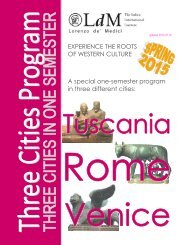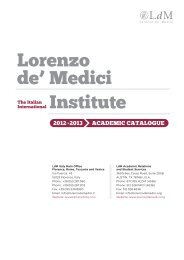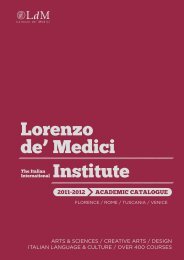aCademiC Catalog 2013-2014 - Lorenzo de Medici
aCademiC Catalog 2013-2014 - Lorenzo de Medici
aCademiC Catalog 2013-2014 - Lorenzo de Medici
Create successful ePaper yourself
Turn your PDF publications into a flip-book with our unique Google optimized e-Paper software.
FLORENCE<br />
School of Arts & Sciences<br />
best summed up by the credo “Man – the measure of all things”.<br />
The focus of this course is therefore upon great personalities<br />
of the Italian Renaissance mainly in the fields of the visual arts,<br />
literature and philosophy, but also drawn from those of politics<br />
and civic life. These inclu<strong>de</strong> key figures of the most prominent<br />
Italian families: the <strong>Medici</strong>, the Sforza, the Della Rovere; artists<br />
and architects: Brunelleschi, Leon Battista Alberti, Leonardo<br />
da Vinci, Michelangelo; writers, poets and philosophers: Dante,<br />
Petrarca, Boccaccio, Pico <strong>de</strong>lla Mirandola, Machiavelli, as well as<br />
merchants and bankers. All these individuals left their mark in<br />
Italy between the early 1400s and the late 1500s.<br />
Prerequisites: HIS 130 Western Civilization, or equivalent<br />
The Role of Magic in Renaissance Thought<br />
HIS 318 F; Dual listed: PHR 318 F<br />
Cr: 3; Contact hrs: 45<br />
During the Italian Renaissance an extraordinarily talented<br />
collection of writers and thinkers embarked on a voyage of<br />
rediscovery, uncovering the rich body of knowledge left by<br />
ancient civilizations and creating a new and exciting synthesis<br />
from what they found. In this synthesis magical thought<br />
exerted a central and prestigious influence. Regar<strong>de</strong>d as the<br />
key to un<strong>de</strong>rstanding the nature of reality, magic occupied<br />
much the same place held by natural science in today’s society.<br />
This course explores the spiritual and magical world conjured in<br />
the thought of important Renaissance thinkers such as Marsilio<br />
Ficino, Pico <strong>de</strong>lla Mirandola and Giordano Bruno, examining their<br />
texts and visiting sites in Florence which ma<strong>de</strong> this city one of<br />
the great centers of Renaissance magic. By reinterpreting the<br />
Renaissance in the light of magic and imagination, the course<br />
offers a fresh perspective on the origins of the mo<strong>de</strong>rn world.<br />
Prerequisites: PHR 130 Western Philosophy, or HIS 130 Western<br />
Civilization, or equivalents<br />
Muslims, Jews and Witches: Outsi<strong>de</strong>rs in<br />
Medieval and Renaissance Europe<br />
HIS 320 F<br />
Cr: 3; Contact hrs: 45<br />
In the Medieval and Renaissance period Christianity provi<strong>de</strong>d<br />
Europeans with a strong cultural i<strong>de</strong>ntity that <strong>de</strong>termined both<br />
the perception of otherness and the mechanisms of social<br />
exclusion. This course analyzes European attitu<strong>de</strong>s toward<br />
“outsi<strong>de</strong>rs” and examines the different patterns of relationship,<br />
discrimination, and persecution that emerged. The “others” lived<br />
far from Europe. The relationship with Muslims will be analyzed<br />
through the concept of holy war (in both versions, Jihad and<br />
Crusa<strong>de</strong>) while Columbus will gui<strong>de</strong> us to the encounter with<br />
the Native Americans. The “others” lived in Europe. Because of<br />
their religious diversity Jews were often perceived as potentially<br />
dangerous, suffering discrimination and persecution. Likewise<br />
for heretics, whose doctrinal and theological errors were not<br />
tolerated, or witches, who were believed to be inspired by the<br />
<strong>de</strong>vil, and thus blamed for crimes that ultimately originated in<br />
collective fears, Europe’s inner <strong>de</strong>mons.<br />
Prerequisites: HIS 130 Western Civilization, or equivalent<br />
Archaeology Field School: Petra and<br />
Shawbak (Jordan)<br />
HIS 323-324 F; Dual listed: CLA 323-324 F<br />
Cr: 6; Contact hrs: 148<br />
The Archaeological Field School of Petra and Shawbak<br />
(Jordan) is a four-week intensive course in medieval Near<br />
Easter Archaeology. Participants in the field school will<br />
learn basic archaeological techniques in the ongoing Light<br />
Archaeology research on Crusa<strong>de</strong>r-Ayyubid and Mamluk<br />
medieval settlement in south Jordan, including excavation,<br />
artifact analyses, stratigraphic building archaeology, landscape<br />
and architectural survey, restoration, tourist master planning<br />
and 2D/3D virtual mo<strong>de</strong>ling. The course will be conducted by<br />
an expert team of English speaking archaeologists, restorers,<br />
architectural historians, territorial and static engineers,<br />
computer scientists and geologists. It will combine on-site<br />
fieldwork mainly in Shawbak (once “Mont Real”, the Crusa<strong>de</strong>r<br />
capital castle of Transjordan) and Petra (Crusa<strong>de</strong>r castles of<br />
Al-Habis and Al-Wu’aira) and a number of on-site lectures.<br />
Through this course stu<strong>de</strong>nts will explore material culture<br />
and architectural production on the historic Frontier between<br />
Mediterranean and Arabia as well as settlement dynamics<br />
that brought to life, during the Middle Ages, the geo-political<br />
settings of Middle East as we know it today. The Medieval Petra<br />
Project has been carried out by the University of Florence since<br />
1986, in collaboration with the Department of Antiquities of<br />
Jordan, the Italian Ministry of Foreign Affairs and the European<br />
Union.<br />
Rise and Fall of the <strong>Medici</strong><br />
HIS 340 F<br />
Cr: 3; Contact hrs: 45<br />
The course <strong>de</strong>als with the full story of this extraordinary family,<br />
whose fortunes are traced over three hundred years (from the<br />
late 14th century up to the early 18th century), from the rise<br />
of the bank un<strong>de</strong>r Cosimo the El<strong>de</strong>r to the final collapse of<br />
the house of <strong>Medici</strong> with the <strong>de</strong>ath of the last <strong>Medici</strong> in 1737.<br />
Since the power of the <strong>Medici</strong> family enabled its members<br />
to rule Florence, control the papacy, act as the “needle of<br />
the Italian compass,” and sometimes influence the policies<br />
of an entire continent, the course will provi<strong>de</strong> stu<strong>de</strong>nts with<br />
an un<strong>de</strong>rstanding of the history, politics and civic life of this<br />
period. The <strong>Medici</strong> were statesmen, scholars, patrons of art,<br />
collectors, entrepreneurs and impresarios. Some of them were<br />
poets, others were popes. The course introduces stu<strong>de</strong>nts to<br />
philosophy and artistic movements by discussing the most<br />
important achievements and the people who worked for the<br />
<strong>Medici</strong>, like Michelangelo, Poliziano, Donatello, Botticelli, and<br />
several musicians who worked at the <strong>Medici</strong> court in the 16th<br />
and 17th centuries. Visits to churches, museums, palaces and<br />
galleries, which are a significant part of the study of the <strong>Medici</strong><br />
family, will supplement classes.<br />
Prerequisites: HIS 130 Western Civilization, or equivalent<br />
Political Terrorism<br />
HIS 380 F<br />
Cr: 3; Contact hrs: 45<br />
Terrorism means the calculated use of violence (or threat<br />
of violence) against civilians in or<strong>de</strong>r to attain goals that<br />
are political or religious or i<strong>de</strong>ological in nature; this is done<br />
through intimidation, coercion, instilling fear and, in the worst<br />
case, violent attacks on people. This word “terrorism” comes<br />
from “Terror,” a term that was first used during the French<br />
Revolution to <strong>de</strong>scribe the political use of strength to suffocate<br />
(or <strong>de</strong>stroy) the opponents of the Republic. The 20th century<br />
shows how this form of violence still remains, used by totalitarian<br />
regimes. However, nowadays terrorism means violent actions,<br />
in most cases illegal and clan<strong>de</strong>stine, carried out in or<strong>de</strong>r to<br />
overthrow or<strong>de</strong>r and the legal government. Starting from this<br />
distinction, this course examines the main geopolitical areas<br />
that faced terrorism in the past and still do. Every terrorist<br />
phenomenon is individual, but by examining the socio-political<br />
and cultural environment we can un<strong>de</strong>rstand common reasons<br />
and similar consequences. In the first part we will <strong>de</strong>al with the<br />
“terror regimes of 1900s’”(Fascism, Nazism, Stalinism and the<br />
Latin American dictatorships); in the second we will study the<br />
different forms of “anti-government” terrorism grouped by their<br />
goals: anticolonialistic groups (Algeria, India), in<strong>de</strong>pen<strong>de</strong>nce<br />
movements (ETA, IRA), communist and anti<strong>de</strong>mocratic groups<br />
(Brigate Rosse, RAF), in<strong>de</strong>pen<strong>de</strong>nce and religion (Palestinian<br />
terrorism), up to the current global threat of Al-Qaeda.<br />
Prerequisites: HIS 130 Western Civilization, or equivalent<br />
The Second World War<br />
HIS 390 F<br />
Cr: 3; Contact hrs: 45<br />
The Second World War caused the <strong>de</strong>ath of about 50 million<br />
people and enormous <strong>de</strong>struction all over the world. The<br />
course examines the causes of the war, focusing upon the<br />
rise of Nazism in Germany. It then focuses on the course of<br />
the war from a political, social and military point of view,<br />
taking into account the political strategies of the main powers,<br />
the most important war campaigns and the suffering of the<br />
civilian populations. A special session will be <strong>de</strong>voted to the<br />
great tragedy of the Holocaust. The course will conclu<strong>de</strong> by<br />
examining the political consequences of the conflict: the new<br />
balance of power that was to last for almost 50 years, until the<br />
collapse of the Soviet Union.<br />
Prerequisites: HIS 130 Western Civilization, or equivalent<br />
66<br />
LdM Aca<strong>de</strong>mic <strong>Catalog</strong> <strong>2013</strong>-<strong>2014</strong>





